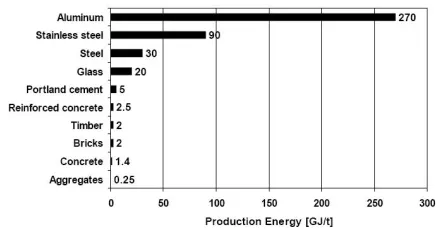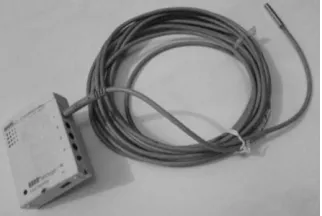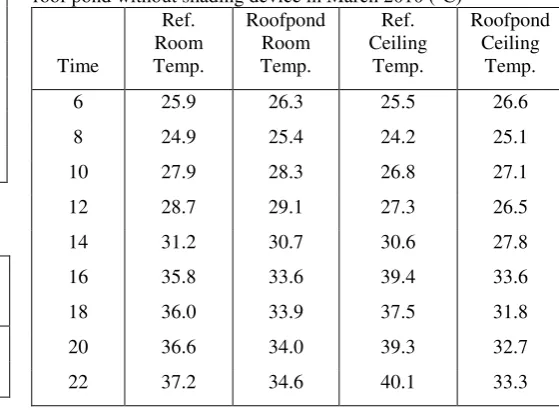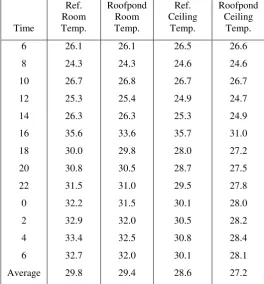“Sustainable Technology Based on Environmental and Cultural Awarenes“
1. INTRODUCTION
The flat concrete roofing system installed is often dominated by the commercial buildings that are the shopping malls, and rental offices. The shop-houses or shop-offices which have been built mostly with two to three-story buildings are the most use of flat roof system. Those flat roofs are constructed with light weight concrete. A few of flat concrete roofs is equipped with insulation on the ceiling; even some shop-houses or offices are finished without putting ceiling on it. The heat of the solar sun radiation impacted on the flat concrete roofs will cause the soar of the cooling loads in buildings which rely on air conditioning for thermal comfort.
A research done by Mintorogo (2008) about the intensity of solar irradiation impacted on horizontal surfaces in Surabaya showed monthly average hourly of global irradiation of 363 Wh.m-2 and monthly average total irradiation of 3,925 Wh.m-2 throughout the rainy seasons. In the meantime during the hot seasons, monthly average hourly and total global irradiation is 396, and 5,158 Wh.m-2 respectively. That solar heat global irradiation impacted on flat bare concrete roofs will be
minimized by using roof pond which is shallow water filled on the concrete flat roofs; the roof pond will commonly be covered with moveable insulation during the daytime and will be opened during the night-time. It is not only a passive-cooling system but is also an interactive cooling system. Roof pond will be an energy conservation and savings domain. Hence, various researchers (Kharrufa 2008; Spanaki 2007; Erell 2006; Chungloo 2006; Jain 2006; Bencheikh 2004; Nahar et al 2003; and Raman et al 2001) have further been investigated and modified the effectiveness of roof pond for cooling day and night in the hot arid and temperate tropic climate; few roof pond system is developed or researched in the warm humid tropic climate. This paper will investigate the effectiveness of roof pond to achieve as one of sustainable roofing systems in warm humid tropical climate.
1.1 Sustainability factors in roofing system
The sustainability has the meaning of using as much as possible natural and renewable energy resources to fulfil the needs of energies in buildings today without burdening the needs of energies in the
Sustainable Flat Roof Pond System in Tropical Climate of Surabaya
Danny Santoso Mintorogo
1Department of Architecture, Tropical Housing Studies, Petra Christian University, Surabaya, Indonesia
Mohd. Hamdan Achmad
2Institute Sultan Iskandar, Universiti Teknologi Malaysia, Johor Bahru, Malaysia
ABSTRACT: In the era of sustainable concepts and environmental friendly concerns, flat bare concrete deck on shop-houses may be unsustainable to handle the excessive solar heat radiation impacted on the horizontal bare roof concrete surfaces without putting any insulation. An alternative and appropriate roofing system to cope with excessive heat solar radiation is needed that the roof system will lead to sustainable factors likes energy savings, less energy body used on the roofing materials, and less damaging environmental roofing materials. This paper discusses a roof pond that is a flat concrete with certain depth of water levels to minimize the cooling loads during the daytime, and performances nocturnal radiant cooling throughout the night-time. Such interactive and passive cooling systems to deal with solar heat irradiation impacted on flat roof as cooling loads, the concrete roof acting as thermal mass will absorb internal sensible and latent heat loads for the period of hours of daylight, and obstructs irradiation with insulation panels at daytime. The shallow water pond at flat concrete roof performances as heat sink, and will release the heat from water pond to nocturnal cool night with opened insulation panels.
future. According to Karen Liu from National Research Council Canada that a sustainable roofing system has to be :
“a roofing system that is designed, constructed, maintained, rehabilitated and demolished with an emphasis throughout its life cycle on using natural resources efficiently and preserving the global
environment.”
Three tenets of sustainable roofing are minimizing the burden on the environment, saving or conserving energy, and extending roof lifespan (Liu 2008). Keeping the environmental friendly factors could be using nonhazardous waste on roofing materials and adopting green procurement policies, as well as recycled roofing products. Saving and conservation energies domains are minimizing cooling loads by using reflective and white covering roof surface materials, and reducing embodied energy on roof system products. A research showed that reinforced concrete as building structure and rooftop flat deck will only need 2.5 GJ/t of energy production of extracting, transporting, and manufacturing raw materials into building materials than steel of 30 GJ/t. Table 1 shows the energy production for concrete and other common building materials; reinforced concrete rooftop flat deck is going to be a sustainable building materials in terms of its low embodied energy used.
Table 1: Embodied Energy used for various Building Materials Iyad (Ed) et al (2009)
1.2 Problem statement
Because of the highly used of the bare flat concrete roof system on commercial buildings—shop houses and mostly equipped with air conditioning system, the cooling loads are the major concerns to achieve one of the sustainable architecture today. A roof
pond roofing system will diminish those cooling loads on flat concrete roof throughout the daytime.
2. RESEARCH GOAL
In order to cope with the excessive heat solar irradiation on low latitude and warm humid tropical climate of Surabaya, an alternative flat concrete roof filled with shallow water roof system is to be proposed to handle for sustainable roof system.
3. LITERATURE REVIEWS ASHVE 1958; Houghton 1942). Two year after that, Harold Hay published the roof pond cooling technique which appeared in the international bibliography (Hay 1969; Yellott 1969). Now roof the work of roof pond and the disadvantages are that the roof needs to watertight and adds extra strength of 200 to 400 kg/m2 to the roof structures.
There are some types of modified roof pond techniques:
3.2 Uncovered roof pond with sprays
“Sustainable Technology Based on Environmental and Cultural Awarenes“
3.3 Uncovered roof pond without sprays
This roof pond system needs pond depth at least 300mm deep and the water temperature tends to increase during daytime due to solar irradiation gains; the water temperature will compensate spontaneously with evaporative effect and convective cooling from prevailing wind. The standard water temperature oscillation is around 5oC. The heat absorbed from solar sun radiation will be contrariwise quantity to the bottom reflection (Spanaki 2007; Hay 1969; Yellott 1969).
3.4 Ventilated roof pond
There are shading panels over the roof pond (second roof) and it has permanent air gaps between the pond and the panels. This situation will lead to maximize the windy convective effect taken place day and nighttime; so the water temperature will around 1-2oK above the average ambient WBT. The ceiling temperature of concrete roof will be around 2oK of water temperature which always follows the average ambient WBT (Spanaki 2007; Givoni 1994). This system will has worked effectively in dry regions with the maximum WBT not exceed 24oC even the DBT exceeds 40oC during daytime.
4. METHODOLOGY
4.1 Experimental models
Two different model types with the same dimension for the experimental study were used to obtain the thermal performances. The dimension is 1m wide x 1m length x 1 m height; the floor on the model is lifted over 0.5 m from the bottom model to avoid over heated from the base roof. The roof models are made up of flat concrete of 8cm thick and have V-shape shading covers over the concrete roof models.
There would be two types of testing: one type is without V-shape shading device for 15 days and other 15 days is covered with V-shape shading device (figure 1).
(a) (b)
Figure 1: without shading device (a); with V-shape shading device (b).
Two models are to be tested simultaneously; the bare flat concrete roof acts as reference model and others will be tested as roof pond model. The water level on roof pond model will always be kept to 25cm height (as the maximum shallow pond); where the deep pond is 30 to 50 cm. All walls and floors on the models are equipped with 2cm foam insulation panels, and then the Portland cement board of 3mm panels are put outer part side by side to the foam insulation panels on the models.
4.2 Instrument tests
The measuring equipment is one piece of HOBO U15 with four external data logger water/soil temperature sensors. 1 sensor is connected to Pakis-stem-block; and other one sensor is clinged to concrete surface. Another 1 sensor is sticked to the internal concrete model; and the rest is for the interior temperature. The HOBO U family has a mesurement range of temperature from -20oC to 70oC; Rh is 5% to 95%. The external input channels have a 0 to 2.5 DC volts; and the mesurement range is -40oC to 50oC in water, while it ranges -40oC to 100oC in air.
Figure 2: HOBO U Family Data Logger and External Water or Soil Sensor
5. RESULTS AND DISCUSSION
The experimental temperature data are taken at 10 minutes interval and it counts for a hourly average (6 am to 6 am the next day). The bare flat concrete model as reference model is presented with the ceiling concrete and room temperatures; as so the roof pond model. All temperature data shown at this paper are collected and presented in 6 months period—January to June 2010.
hotter 0.5oC than reference model (bare flat concrete), and average roof pond ceiling temperature is 1.1oC greater than reference model’s temperature. It seems that the shallow-water at flat concrete roof as cooler is so less effective to cool the roof in no shading domain that almost hourly average concrete ceiling temperatures are greater than those of ceiling reference temperatures.
Table 3 shows the roof pond system works effectively to cool the roof in the mode of putting V-shape shading devices; it can diminish the heat roof temperature by 0.2oC on both the roof and ceiling temperatures. In January, although the bare flat concrete roof and roof pond have been poured by heavy rain, the solar heat sun radiation still affects the rooftop flat roofing regardless of having shallow pond or not. Shading devices can cut off solar heat radiation on flat concrete roof (table 3).
Table 2: Thermal performance of bare flat concrete roof and roof pond without shading device in January 2010 (oC)
Time roof pond with shading device in January 2010 (oC)
Time
March is the hottest month among the first half-year; because the sun position is in the equator making the distance between the sun and the earth shorter; the table 4 and table 5 show those highest bare flat roof temperature and roof pond temperature with or without V-shape shading devices among the 7 tables (January through June 2010). Roof pond temperature compared to bare flat concrete roof with putting V-shape shading panels (table 5).
Table 4: Thermal performance of bare flat concrete roof and roof pond without shading device in March 2010 (oC)
“Sustainable Technology Based on Environmental and Cultural Awarenes“ roof pond with shading device in March 2010 (oC)
Time devices. Ceiling temperature difference of 0.4oC has been achieved by roof pond system than conventional concrete flat roof without shading devices in June 2010 (table 6). With placing V-shape shading devices, roof pond system can decrease 1.4oC in ceiling temperature than flat bare concrete roof system (table 7).
Table 6: Thermal performance of bare flat concrete roof and roof pond without shading device in June 2010 (oC)
Time roof pond with shading device in June 2010 (oC)
Time
by roof pond. Moreover, accordingly, it is apparently that by placing V-shape shading devices over any roof will not merely cool the roof greater than conventional roofing system—open roofing, but it also enhanced the sustainability roof. Roof pond will not only lessen the conducted solar heat radiation, but it also cools the mass of concrete almost in every hour of inner bare concrete ceiling. The cool concrete ceiling will absorb room heat—latent and sensible with its cool massing—ceiling during the daytime and re-cool it by nocturnal cooling process at nighttime.
7. ACKNOWLEDMENT
I would like to express my sincerly to Mrs. Wanda KW Canadarma for her help in sorting the data.
REFERENCES
Alsamsam, I., Lionel I., Martha G.V.G. (2009): Sustainable high performance concrete buildings, Illinois.
ASHVE Guide. (1958): Cooling load. 13: Table 9, pp.309. Cook. J. (1985): Passive cooling. London. MIT press.
Givoni, B. (1994): Passive and low energy cooling. Van Nostrand Reinhold.
Houghton, F. C., Olson, H.T., Gutberlet, C. (1942): Summer cooling load as affected by heat gain through dry, sprinkled and water-covered roof. ASHVE Trans,. 46, 231.
Hay, H.R., Yellott, J.I. (1969) Trans. ASHRAE 75, Part 1, 165. Liu, K. (2008): Towards sustainable roofing. National research
council Canada.
Mintorogo, D. S. (2008): Solar radiation behaviour on horizontal surface in tropical climate of Surabaya.
Spanaki, A. (2007): Comparative studies on different types of roof pond for cooling purposes: literature reviews. Proceedings of the 2nd Palenc and 28th AIVC conference on building low energy cooling and advanced ventilation technologies in the 21st century, pp 1009-1015.
Tiwari, G.N., Kumar, A., Sodha, M.S. (1982): A review-cooling by water evaporation over roof. Energy conversion and management, 22, 143-53.



